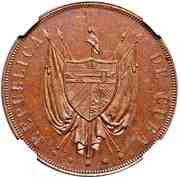Предметы Куба
Do you want to take a photo with the camera or select an existing image?
(en) Cuba is the biggest island of the Antilles, at Caribs sea, placed in a privileged position between Miami and Yucatan peninsulas. During colonies time, it was a very valuable point of contact to Europe, hence the nickname of "Key of the Caribs", illustrated on their coat of arms showing a key between 2 peninsulas, and by the Cuban minthouse mark being a key. During colonial times, Cuba did not have an own minthouse, and received scarce sending of coins from Mexico mint, known as "Situados". These were not enough, and many Spanish coins were used, mainly from Seville mint, so they were called "Sevillanas". Those coins had a real value lower then the colonial minted ones, but they were exchanged at same value of colonial coins. To avoid this, in 1841, many were countermarked to "clean" the circulating coinage. On 1741, during the siege to Santiago de Cuba, copper coins were minted - the first in Americas. First Cuban coin is considered to be the "Peso Souvenir", minted to finance the freedom campaign on 1897. Minted in the US, "1 Peso" was replaced with "Souvenir" word. The following year same type of coins were minted displaying a "1 Peso" face value. First coinage from Cuba as independent country started with 1915 and 1916 series, including copper-nickel, silver and gold coins. These were engraved by the famous Edward Barber, from the US, and the obverse is still used on actual coins. From 1994, Cuba has double currency, the original Peso Cubano (CUP) from 1915, that never changed (copper-nickel coins still are legal tender), and the Peso Convertible (CUC) originally intended to be used by visitors and Cubans living overseas. CUC is commonly paired to USD value, and CUP is about 1/25 CUC. From a few years ago, government is considering to return to use only 1 currency. Today Cuba strikes all its circulating coins and most of the commemorative issues through its own minthouse, that started production on 1977. Cuba has maintained the design of circulating coins, with minor changes, and introduced 2 bimetallic coins of 5 CUC in 2004 (dated 1999), and 5 CUP in 2016. More noticeable differences are found on commemorative circulating issues. Cuba hase produced a huge variety of commemorative coins from 1977, based on themes such as sports, Cuban history, monuments, flora & fauna, FAO, Hispanic-American themes, etc.
- Countermarked Real (1841)
- Pre-Republic (1870-1898)
- Revolutionary Fund (1872-1877)
- Cuban Peso (moneda nacional, 1914-date)
- INTUR (visitor's coinage, 1981-1989)
- Convertible peso (1994-2020)
Countermarked Real (1841)
Decolonization deprives Cuba, loyal to Spain, of the currencies from Mexico, Lima, and Potosí, causing a shortage. The clandestine introduction of the "real de vellón" leads to economic disorder. A royal decree in 1841 mandates countermarking.
1772-1788 (1841)
Монеты чрезвычайных ситуаций › Официальные монеты дополнительного выпуска
Серебро 903 • 6.77 g • ⌀ 26 mm
KM# 1.1, N# 78553
1773-1788 (1841)
Монеты › Стандартные монеты обращения
Серебро 903 • 6.77 g • ⌀ 26 mm
KM# 1.2, N# 78607
1788-1808 (1841)
Монеты › Стандартные монеты обращения
Серебро 903
KM# 2, N# 109068
1793-1808 (1841)
Монеты › Стандартные монеты обращения
Серебро 812 • 6.77 g • ⌀ 26 mm
KM# 3, N# 108366
1811-1814 (1841)
Монеты › Стандартные монеты обращения
Серебро 903
KM# 4.1, N# 109069
1810-1812 (1841)
Монеты › Стандартные монеты обращения
Серебро 814 • 6.77 g
KM# 4.2, N# 109070
1814-1833 (1841)
Монеты › Стандартные монеты обращения
Серебро 903
KM# 5, N# 109071
1815-1833 (1841)
Монеты › Стандартные монеты обращения
Серебро 903 • 5.8 g • ⌀ 26 mm
KM# 6, N# 62988
1812-1814 (1841)
Монеты › Стандартные монеты обращения
Серебро 903
KM# 9, N# 109072
1808-1813 (1841)
Монеты › Стандартные монеты обращения
Серебро 903
KM# 7, N# 109073
1810-1812 (1841)
Монеты › Стандартные монеты обращения
Серебро 903
KM# 8, N# 109074
1822-1823 (1841)
Монеты › Стандартные монеты обращения
Серебро 903
KM# 10, N# 109075
1823 (1841)
Монеты › Стандартные монеты обращения
Серебро 903
KM# 11, N# 109076
1789 (1841)
Монеты › Стандартные монеты обращения
Серебро 903 • 5.9 g • ⌀ 26 mm
KM# 12, N# 109077
Pre-Republic (1870-1898)
1872-1883
Банкноты › Местная банкнота: Banco Español de La Habana
70 × 31 mm
P# 29, N# 219710
1896
Банкноты › Стандартная банкнота: Banco Español de la Isla de Cuba
71 × 36 mm
P# 45, N# 202471
1872-1883
Банкноты › Стандартная банкнота: Banco Español de La Habana
77 × 33 mm
P# 30, N# 219524
1897
Банкноты › Стандартная банкнота: Banco Español de la Isla de Cuba
83 × 39 mm
P# 52, N# 219521
1897
Монеты › Монеты не для обращения
Серебро 900 • 22.5 g • ⌀ 36 mm
X# M3, Y# 1, N# 119214
1897
Монеты › Монеты не для обращения
Серебро 900 • 22.5 g • ⌀ 36 mm
X# M1, Y# 1, N# 119212
1897
Монеты › Монеты не для обращения
Серебро 900 • 22.5 g • ⌀ 36 mm
X# M2, Y# 1, N# 70511
1898
Монеты › Стандартные монеты обращения
Серебро 900 • 22.55 g • ⌀ 36 mm
KM# A8, Y# 2, N# 34181
ND (1905)
Банкноты › Стандартная банкнота: National Bank of Cuba (private)
180 × 80 mm
P# 65, N# 212886
ND (1905)
Банкноты › Стандартная банкнота: National Bank of Cuba (private)
180 × 80 mm
P# 68A, N# 299044
ND (1905)
Банкноты › Стандартная банкнота: National Bank of Cuba (private)
180 × 80 mm
P# 66, N# 212889
ND (1905)
Банкноты › Стандартная банкнота: National Bank of Cuba (private)
180 × 80 mm
P# 68B, N# 299043
Numista рецензент для монет этого эмитента - adanieluy.
Numista рецензент для банкнот этого эмитента - adanieluy.
Numista рецензент для экзонумии этого эмитента - adanieluy.
Предмет отсутствует в каталоге? Добавьте сами! (на Английском)

























































































